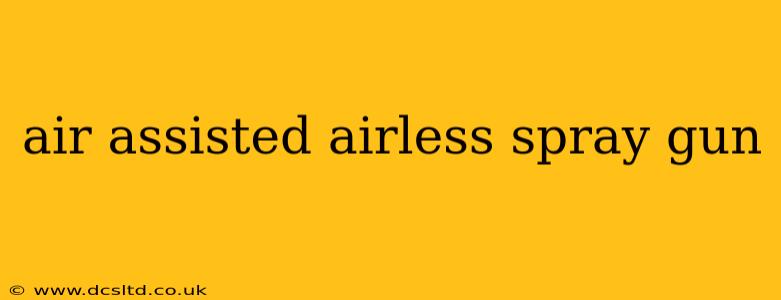Air assisted airless spray guns represent a fascinating blend of airless and conventional air spray technologies, offering a unique set of advantages for various painting applications. This guide delves into the specifics of these hybrid spray guns, explaining their functionality, benefits, and ideal use cases. We'll also address common questions surrounding their operation and maintenance.
What is an Air Assisted Airless Spray Gun?
An air assisted airless spray gun combines the high transfer efficiency of airless spray technology with the atomizing power of compressed air. Unlike traditional airless spray guns that rely solely on hydraulic pressure to atomize the paint, air assisted models utilize compressed air to further refine the spray pattern, resulting in a finer finish and better control over the application. This hybrid approach makes them a versatile choice for a wider range of materials and applications.
How Does an Air Assisted Airless Spray Gun Work?
The mechanism involves a pump generating high pressure to force the paint through the gun. However, instead of relying solely on the pressure to atomize the paint, compressed air is introduced at the nozzle tip. This air stream atomizes the already pressurized paint further, creating a finer mist and reducing overspray. This dual-action process leads to superior atomization and control, allowing for a more even and precise finish.
What are the Advantages of Using an Air Assisted Airless Spray Gun?
Several key advantages distinguish air assisted airless spray guns from their purely airless or air spray counterparts:
- Improved Finish Quality: The finer atomization results in a smoother, more even finish with less orange peel.
- Reduced Overspray: The controlled atomization minimizes paint waste, leading to cost savings and a cleaner work environment.
- Versatile Material Handling: These guns can handle a wider range of materials, including thicker paints, stains, and specialized coatings that might be difficult to spray with a standard airless gun.
- Better Control: The addition of air pressure gives the user more precise control over the spray pattern and application, making it easier to achieve the desired finish.
- Increased Transfer Efficiency: While still less efficient than pure airless, air assisted systems offer significantly improved transfer efficiency compared to conventional air spray guns.
What are the Disadvantages of Air Assisted Airless Spray Guns?
While offering many benefits, it's crucial to acknowledge some limitations:
- Higher Initial Cost: Air assisted airless spray guns typically cost more than standard airless guns.
- More Complex Setup: Requiring both a pump and an air compressor adds to the complexity of setup and operation.
- Increased Maintenance: The added air compressor and more intricate mechanism necessitate more frequent maintenance.
- Potential for Air Pressure Issues: Improper air pressure can lead to inconsistent spray patterns or poor atomization.
What Types of Projects are Ideal for Air Assisted Airless Spray Guns?
These versatile guns excel in a variety of applications:
- Fine Finishing: Ideal for projects demanding a flawless finish, such as furniture painting, cabinetry, and automotive refinishing.
- Applying Specialized Coatings: Suitable for spraying materials like lacquers, enamels, and other high-quality coatings.
- Large Surface Areas: While efficient for smaller projects, their capacity makes them suitable for larger painting jobs.
- Projects Requiring Precise Control: The superior control makes them well-suited for intricate detailing work.
How Much Does an Air Assisted Airless Spray Gun Cost?
The cost varies significantly depending on the brand, features, and overall quality. Expect to pay more than a standard airless spray gun, with prices ranging from several hundred to several thousand dollars.
What is the Difference Between Airless and Air Assisted Airless Spray Guns?
The key difference lies in atomization. Airless guns rely solely on high pressure for atomization, resulting in a coarser spray pattern. Air assisted guns use high pressure plus compressed air for finer atomization and better control.
How Do I Clean an Air Assisted Airless Spray Gun?
Cleaning is crucial for maintaining the gun's performance and longevity. Always consult the manufacturer's instructions for specific cleaning procedures. Generally, this involves flushing the system with a suitable cleaning solvent, followed by thorough rinsing with water or thinner, depending on the paint used.
What Safety Precautions Should I Take When Using an Air Assisted Airless Spray Gun?
Safety is paramount. Always wear appropriate personal protective equipment (PPE), including a respirator, safety glasses, gloves, and protective clothing. Work in a well-ventilated area, and follow all manufacturer's safety guidelines.
This comprehensive guide provides a solid foundation for understanding and utilizing air assisted airless spray guns. Remember to always prioritize safety and consult your manufacturer's guidelines for specific instructions and maintenance.
